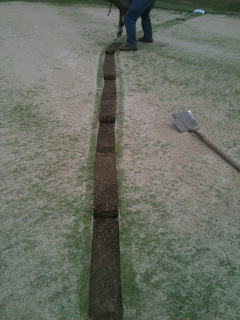These are called furrows. They allow for additional drainage of water during winter months.
The sod we cut out of the greens, we placed in the bunkers. We will replace this sod in the spring.
In an effort to conserve our capitol expenditures, we have utilized several covers that with much TLC will hopefully adequately protect us for the winter. These covers were purchased 15-20 years ago.
The idea of green covers:
The Other Side of Covers
Courses across the north-central tier of states have recently completed the annual tasks of winterizing the irrigation system and applying snow mold fungicides to high priority playing surfaces. With cold, snowy weather looming, many superintendents now wonder if there are any other options available for protecting the course from winter-related damage during these final few weeks of late fall.
A moderately heavy application of sand topdressing made after winter disease protection is applied is not a bad idea, regardless of where in the Region your course is located. The sand provides a fairly good level of protection from wind desiccation during an open winter and the addition of more sand into the upper root zone helps dilute excess organic matter accumulation that occurs between late fall through mid spring. In addition, just about any type of geotextile cover can help prevent damage to turf across open, elevated, windswept greens or tees that have a history of winter desiccation.
On the other hand, I cringe when inquiries are made regarding the use of winter covers on greens at golf courses located along the southern border of the Region, for example the Detroit area. The winter climate along this portion of the country is far too unpredictable and, in my opinion, the problems associated with a surge of excessive growth that could occur under a cover will always outweigh any protection from crown hydration the fabric may provide. Covers tend to perform best in areas where there is little risk of an extended mid-winter thaw.
That being said, don't be afraid to cover a poorly drained, localized area of a green that dies year after year due to crown hydration or prolonged ice cover. After all, what's the risk when you are sodding or plugging a portion of this green every spring anyway. Under these conditions, the use of a wood fiber mat or an insulated waterproof cover over the injury prone area of the green is worth a try until the underlying problems associated with poor surface drainage can be addressed by reconstruction or through modification of the surface contours.
Just keep in mind that you need to look past the advertising hype associated with green covers, particularly in areas of the Region where a period or two of mild winter weather is likely to occur before spring. If a product is likely to cause the turf to break winter dormancy, you may be better off covering your backside, by not covering your greens.
A moderately heavy application of sand topdressing made after winter disease protection is applied is not a bad idea, regardless of where in the Region your course is located. The sand provides a fairly good level of protection from wind desiccation during an open winter and the addition of more sand into the upper root zone helps dilute excess organic matter accumulation that occurs between late fall through mid spring. In addition, just about any type of geotextile cover can help prevent damage to turf across open, elevated, windswept greens or tees that have a history of winter desiccation.
On the other hand, I cringe when inquiries are made regarding the use of winter covers on greens at golf courses located along the southern border of the Region, for example the Detroit area. The winter climate along this portion of the country is far too unpredictable and, in my opinion, the problems associated with a surge of excessive growth that could occur under a cover will always outweigh any protection from crown hydration the fabric may provide. Covers tend to perform best in areas where there is little risk of an extended mid-winter thaw.
That being said, don't be afraid to cover a poorly drained, localized area of a green that dies year after year due to crown hydration or prolonged ice cover. After all, what's the risk when you are sodding or plugging a portion of this green every spring anyway. Under these conditions, the use of a wood fiber mat or an insulated waterproof cover over the injury prone area of the green is worth a try until the underlying problems associated with poor surface drainage can be addressed by reconstruction or through modification of the surface contours.
Just keep in mind that you need to look past the advertising hype associated with green covers, particularly in areas of the Region where a period or two of mild winter weather is likely to occur before spring. If a product is likely to cause the turf to break winter dormancy, you may be better off covering your backside, by not covering your greens.
Source: Bob Vavrek, rvavrek@usga.org or 262-797-8743







